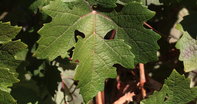
Description
Roobernet is a red grape developed in South Africa in the 1960s by Prof Chris Orffer by crossing Cabernet Sauvignon and Alicante Bouschet. Similar to Pontac, Roobernet is a teinturer variety – its flesh and juice are red instead of clear as in other red cultivars.Origin
South AfricaProduction in South Africa
In South Africa, some 270 ha Roobernet are planted in various regions with the oldest recorded vines established in 1996 in Stellenbosch. The majority of Roobernet plantings can be found in the Breedekloof (56ha), Robertson (52ha), Swartland (42ha), Paarl (43ha) and Stellenbosch (32ha) areas.
Growth and Ripening
It is a vigorous upright grower that produces yields of 8 – 14 ton/ha. A trellis system will accommodate its vigorous growth. Roobernet is a mid to late season ripening cultivar, similar to Cabernet Franc. Average picking ripeness is 21—23° Balling with an acid concentration of 6-7 g/l.
Leaves and Berries
The dark green, shiny leaves are medium-sized, round and deeply five-lobed. Roobernet vines yield big loose bunches with small, round, dark black berries. Skins are tough with a wrinkled appearance when fully ripe. Juicy is blood red.